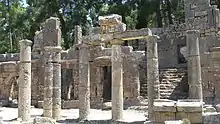Lyrbe
Lyrbe (spelled Lyrba in the 1910 Catholic Encyclopedia; Ancient Greek: Λύρβη) was a city and episcopal see in the Roman province of Pamphylia Prima and is now a titular see.[1]

History
It is only known by its coins and the mention made of it by Dionysius Periegetes,[2] Ptolemy,[3] and Hierocles.[4][5] Dionysius places the town in Pisidia, while William Smith equates Lyrbe with the Lyrope (Λυρόπη), mentioned by Ptolemy and placed by the ancient geographer in Cilicia Trachaea.[6]
It is identified with modern Asarkale,[1] Bucakşeyhler,[7] or Şıhlar.[8]
The Notitiae episcopatuum mention Lyrba as an episcopal see, suffragan of the archbishopric of Side, up to the 12th and 13th centuries. Two of its bishops are known: Caius, who attend the First Council of Constantinople in 381, and Taurianus at the First Council of Ephesus in 431 (Le Quien, Oriens christianus, I, 1009); Zeuxius was not Bishop of Lyrba, as Le Quien states, but of Syedra.[5]
References
- Annuario Pontificio 2013 (Libreria Editrice Vaticana 2013 ISBN 978-88-209-9070-1), p. 918
- Dionysius Periegetes 858,
- Ptolemy. The Geography. 5.5.5.
- Hierocles. Synecdemus. p. 682.
- Sophrone Pétridès, "Lyrba" in Catholic Encyclopedia (New York 1910)
- Ptolemy. The Geography. 5.5.9.
- Lund University. Digital Atlas of the Roman Empire.
- Richard Talbert, ed. (2000). Barrington Atlas of the Greek and Roman World. Princeton University Press. p. 65, and directory notes accompanying.
![]() This article incorporates text from a publication now in the public domain: Smith, William, ed. (1854–1857). "Lyrbe". Dictionary of Greek and Roman Geography. London: John Murray.
This article incorporates text from a publication now in the public domain: Smith, William, ed. (1854–1857). "Lyrbe". Dictionary of Greek and Roman Geography. London: John Murray.